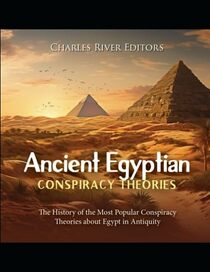This book is an explanation of the biggest conspiracy theories about ancient Egypt. Some seem possible, while some seem outlandish. However, they are interesting reading. You may enjoy this book if you are unfamiliar with these ancient theories. I found the most thought-provoking one to be about Moses. These stories are --
- Akhenaten and Moses
- The Curse of the Pharaohs
- The Secret Chambers in the Great Pyramid and Sphinx
- Ancient Astronauts
- The Lost Army of Cambyses
- Cleopatra's Death
Amenhotep IV (also known as Akhenaten, the heretic king) is thought to be related to Moses. Jewish-Roman historian Flavius Josephus argued that Moses was the leader of Judaism and closely related to Akhenaten, possibly a son or grandson. Manetho, an Egyptian historian, said that Moses was an Egyptian priest who organized the leper's rebellion against forced labor pushed on them by Amenhotep III and others. The most interesting fact about this section was the evaluation that Judaism was unlike any other religion but very similar to Akhenaten's.
When the archeologists started opening the Pharaohs' tombs, people related to the excavations began to die. There has been wild speculation about these deaths. However, someone finally evaluated the 60 workers closest to the openings and found that ten died during the twelve years most closely associated with the excavations.
The next theory is even wilder. Erich Von Daniken said aliens came and taught the Egyptians how to create the Pyramids of Giza and the Sphinx. His theory said that the Egyptians did not have the technology to create them. Edgar Cayce said there was a secret room in the paw of the Sphinx that would explain an advanced civilization that existed a million years ago.
After extraterrestrials in Egypt, some folks believe that long-ago astronauts influenced development on our Earth by landing and assisting humans in creating things (they could not create alone), such as the Moai statues on Easter Island. They also point (on page 59) to airships (similar to our helicopters) in Australian cave paintings of the Wandjina people.
I was unfamiliar with this conspiracy theory regarding the lost army of Cambyses. It happened during a desert storm in 534 BCE. Persian troops specially trained for desert conditions disappeared without a trace while escaping the Egyptians following them. Two Italian archaeologists think they have unearthed the solution. They came across the remains of an army in the desert. Local Bedouins told them that the wind uncovered the bleached bones briefly, and then the wind covered them again with fifteen feet of sand.
Finally, the authors recounted the Ptolemy family history in Egypt. The story ends with the deaths of Cleopatra and Mark Antony. Stories are told that Egyptian archaeologists found Antony's death mask and the tomb of Cleopatra and Antony about 30 miles outside of Alexandria. They say they found 20 coins minted during her reign.
I wasn't overly convinced of the validity of these theories. There wasn't enough proof. The stories were engagingly told. I'm sure these rumors help sell travel tickets to the country. Interesting reading. Overall score = G+.
- Akhenaten and Moses
- The Curse of the Pharaohs
- The Secret Chambers in the Great Pyramid and Sphinx
- Ancient Astronauts
- The Lost Army of Cambyses
- Cleopatra's Death
Amenhotep IV (also known as Akhenaten, the heretic king) is thought to be related to Moses. Jewish-Roman historian Flavius Josephus argued that Moses was the leader of Judaism and closely related to Akhenaten, possibly a son or grandson. Manetho, an Egyptian historian, said that Moses was an Egyptian priest who organized the leper's rebellion against forced labor pushed on them by Amenhotep III and others. The most interesting fact about this section was the evaluation that Judaism was unlike any other religion but very similar to Akhenaten's.
When the archeologists started opening the Pharaohs' tombs, people related to the excavations began to die. There has been wild speculation about these deaths. However, someone finally evaluated the 60 workers closest to the openings and found that ten died during the twelve years most closely associated with the excavations.
The next theory is even wilder. Erich Von Daniken said aliens came and taught the Egyptians how to create the Pyramids of Giza and the Sphinx. His theory said that the Egyptians did not have the technology to create them. Edgar Cayce said there was a secret room in the paw of the Sphinx that would explain an advanced civilization that existed a million years ago.
After extraterrestrials in Egypt, some folks believe that long-ago astronauts influenced development on our Earth by landing and assisting humans in creating things (they could not create alone), such as the Moai statues on Easter Island. They also point (on page 59) to airships (similar to our helicopters) in Australian cave paintings of the Wandjina people.
I was unfamiliar with this conspiracy theory regarding the lost army of Cambyses. It happened during a desert storm in 534 BCE. Persian troops specially trained for desert conditions disappeared without a trace while escaping the Egyptians following them. Two Italian archaeologists think they have unearthed the solution. They came across the remains of an army in the desert. Local Bedouins told them that the wind uncovered the bleached bones briefly, and then the wind covered them again with fifteen feet of sand.
Finally, the authors recounted the Ptolemy family history in Egypt. The story ends with the deaths of Cleopatra and Mark Antony. Stories are told that Egyptian archaeologists found Antony's death mask and the tomb of Cleopatra and Antony about 30 miles outside of Alexandria. They say they found 20 coins minted during her reign.
I wasn't overly convinced of the validity of these theories. There wasn't enough proof. The stories were engagingly told. I'm sure these rumors help sell travel tickets to the country. Interesting reading. Overall score = G+.




